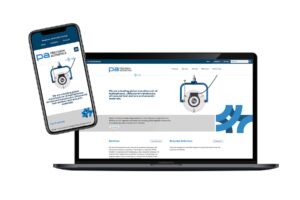Glenn Wedgbrow, Business Development Manager at Micro-Epsilon UK, provides an overview of 7 challenging measurement applications that use the latest laser profile scanning technology to help improve quality control and production performance.
2D/3D laser profile scanners are used to detect, measure and evaluate profiles on a wide range of object surfaces with high precision. Their versatility allows the scanners to measure the profile of angles, steps, distances, extreme values and 3D measurements.
Compact, lightweight sensors with built-in controllers can better serve manufacturing and robotic applications where absolute precision is imperative in the measurement of extremely small structures and gaps. The integration of all the electronics inside a compact sensor body makes the installation of laser scanners much easier, a key advantage in factory automation and machine building applications that provide a very small installation space.
The measuring principle
The sensors with integrated signal processors and optical components project a wide laser line onto the target surface. A compact size combined with higher resolution allows the scanCONTROL 30xx family of scanners to attain new performance levels in quality control.
With dimensions of 96mm x 112mm x 40mm, scanCONTROL 30xx sensors can be easily integrated into various environments. The compact, lightweight sensors provide several interfaces to output measured data directly or via a gateway module, for example, Ethernet, PROFINET, Ethernet/IP and EtherCAT. The freely downloadable scanCONTROL Configuration Tools software from Micro-Epsilon enables engineers to configure and deliver measurement results direct to other plant control systems without having an additional PC or controller permanently connected.
The scanCONTROL 30xx sensors operate according to the international GigE Vision standard, which allows them to be integrated into industrial image processing systems. In addition, the sensors can autonomously execute several measuring programs in parallel while delivering different measurement results per profile.
Example 1: easy integration due to compact size and integral controller
Common laser scanners that use external controllers carry an overhead in terms of both space and weight, which can be a serious limitation when the sensors operate on tight measuring locations. However, a compact laser profile scanner with integral evaluations without requiring an external controller or PC, can be directly integrated to a PLC or other production control system. Equipped with powerful processors and highly sensitive optical components, these scanners ensure precise measurements on almost any surface type. The lightweight scanCONTROL scanners provide the ideal integration solution for robotics applications, inline production monitoring and mobile machines.
Example 2: Blue laser technology for red-hot glowing surfaces
Profile measurements on red-hot glowing targets such as milled steel push traditional sensor technologies to their limits. This is where scanCONTROL Blue Laser technology offers the ideal measurement solution. Blue Laser scanners work at a shorter wavelength of 405nm, which is far from the red part of the visible spectrum. This means it is unaffected by the emitted light from a surface, which is blocked by using a simple optical filter. This method ensures very stable signals. For this reason, scanCONTROL laser scanners achieve excellent signal stability and therefore precise measurement results on red-hot glowing surfaces. Applications involving Micro-Epsilon scanCONTROL Blue Laser scanners measuring on red-hot glowing measurement objects exceeding 700°C are protected by patent law.
Example 3: Blue laser technology for transparent objects
The scanCONTROL Blue Laser scanners also demonstrate their advantages on transparent objects such as plastics, glass, adhesives, silicones, paints, varnishes, coatings, Plexiglas and gaskets. The scanners achieve excellent signal stability on these surfaces and thus precise measurement results. The shorter wavelength of blue light reduces the penetration into the material surface that is seen with traditional red lasers. The advantages of these scanners are also used for measurement on organic objects and reflective metals. Measurement tasks involving blue laser scanners measuring on transparent objects such as glass and plastics are protected by patent law.
Example 4: 3D measurements in the production line
scanCONTROL laser line scanners use the laser triangulation measuring principle for two-dimensional profile detection on different target surfaces. Line optics project a laser line onto the target surface. A high quality optical system images the diffusely reflected light from this laser line onto a sensor matrix. From this camera image, the controller calculates the distance information (z-axis) and the position alongside the laser line (x-axis) and outputs both in a two-dimensional coordinate system. In the case of moving objects or traversing the sensor, a 3D point cloud is obtained from the juxtaposition of the profiles.
Micro-Epsilon laser scanners are used for precise inline 3D measurements in numerous applications. To generate 3D scans, the scanners are moved over the measurement object or vice versa. The scanCONTROL 3000 series offers a comprehensive 3D scanner portfolio with many different measuring ranges, as well as a choice of red or blue laser technologies and an extensive range of accessories. The laser scanners are characterised by high dynamics, precision and their compact size. Due to the low sensor weight, they are also suitable for use in robotics. Via the Ethernet/GigE Vision interface, scanCONTROL scanners can be optimally integrated into image processing software systems.
Example 5: Path planning in welding automation In modern spot welding, additive welding processes and robot welding, all process steps are clocked and carried out with the highest precision. In this respect, high precision sensors from Micro-Epsilon impress in numerous measurement tasks and are used, for example, for control, intensity control and weld path planning. The scanners are used for profile measurements and provide precise profile information of the weld seam, even on difficult surfaces. The calculated paths eliminate deviations from the component tolerance in such a way that the welding head is positioned over the desired seam at all times.
Example 6: Burr measurement in slitting lines
The cutting process causes burrs to form on the cut surfaces of the metal strips. For inline monitoring of the burr, scanCONTROL laser scanners are used, which permanently monitor the sheet edges. Due to the Blue Laser technology, precise measurement values with high signal stability are determined. Limit value transgressions are transferred directly to the control system, allowing the slitting process to be adjusted, for example, by servicing the knives or adjusting the path control.
Example 7: 3D measurement of components prior to plasma cutting
In order to process huge domes quickly, fully automatically and at extreme precision, it is necessary to determine the shape of the domes and their exact position within the production line. As the pure CAD data of the dome often differs by several centimetres from the actual dimensions, the 3D profile of the covers is measured before processing using scanCONTROL laser scanners. The exact dimensions are then determined from the 2D data generated by the scanner which is connected to a 6D position system.
scanCONTROL advanced laser scanner technology
- Compact size and integrated evaluation without an external controller or PC
- Multiple measuring ranges and laser types (red, blue, classes 2/3)
- High profile resolution for detection of the finest of details
- High profile rate for dynamic measurement tasks
- Factory calibration for metals
- Proven operational safety in 24/7 operation over many years
For more information on 2D/3D laser profile scanners, please call the Micro-Epsilon sales department on +44 (0)151 355 6070 or email info@micro-epsilon.co.uk

 Instrumentation Monthly Test | Measurement | Control
Instrumentation Monthly Test | Measurement | Control











